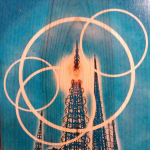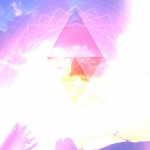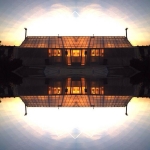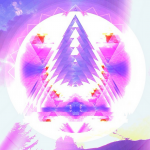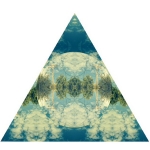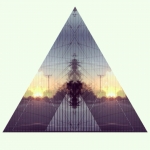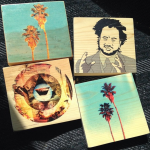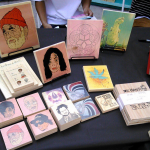Nick Bahula has spent the majority of his life living with and observing the intricacies of nature. His work has the traditional air of tightly rendered nature illustrations but with a highly emotional range of surreal metaphorical themes.
In his paintings and photographs he presents his vision of the natural elements in the city; a portal into nature. His wide array of subjects – splashes of sunlight peaking over a dirty brick wall; abstract shots of telephone poles; trees; leaves – are inspired both by the cityscapes that raised him, and his unceasing intrigue with natural imagery. Over Bahula’s 15+ year career, he has developed a process of transferring his original paintings and photographs to reclaimed wood blocks, where he balances imagery found in nature and the city that create intricate and vibrant illusions of balance and symmetry. Bahula’s incredible photographs have the appearance of simplicity, but are actually quite complex. Each photograph features basic lines, arcs, and geometric forms, saturated with lush earthy colors, but upon second glance reveal how the artist has turned his original compositions sideways and upside down so that viewers will focus on the shapes rather than just the images.
Whether it’s the imagery, colors, or creative process, Bahula relies on nature to intervene with each piece. He fashions photographs and his wildly popular image-based wood blocks to give nature a voice and a persona in the midst of his urban environment.
It seems like you find a lot of inspiration from nature and the environments you inhabit here in Southern California. How do you think your environment and setting have an influence on your work? Does it play in to your color palette?
I’m lucky to live close to the places I love. Living in the Inland Empire, puts me about 2 hours away from something awesome in all directions. I live at the base of the San Bernardino Mountains where I taught environmental education for 10 years. I spent most of those years hiking around with kids during the week. My own children enjoy being outside so we go hiking locally a lot. I can’t help but be inspired by all the color found during those outings. My work is mostly nature based. I try to recreate the feelings I have when I am outdoors.
You’ve been making art for a long time now, 15 years, how do you keep it interesting for yourself? What makes you get up early in the morning and work on your art?
I go through bursts where I create as much as I can. Spilling things out onto canvas or wood blocks. Sometimes I take a break and let the ideas stack up. I sleep very little and try to use any free time I can to create. Having a family leaves little time to make things so I keep my studio in the garage. Sometimes I will find myself in the garage at 3:00am working on some blocks. If I’m preparing for a show I will wake up at 4:00am and put in a few hours before the day job. After work I’m able to spend time with my kids. They like to paint so we will hang out in the garage watching old tapes and make a mess together. Making art for me is not a choice. It’s something I can’t help but do. I also love the hell out of it.
You use a lot of watercolors and powdered paints in your pieces originally, but recently you’ve been working extensively with imagery on wood. How did this idea evolve and come to be?
Canvas was my first love. I use to tack up a few yards of canvas to my bedroom wall and would make these large 8-foot paintings. I would buy furring strips from Home Depot and stretch my own canvas. My wife and I moved into our house 6 years ago and that gave me a ton of space to spread out and make stuff. I started experimenting with powdered paint and rain in my back yard. I really loved the drips and moving the canvas around to create the backgrounds. But between the residential job I worked and the birth of our first child, I had limited time. I moved on to working with wood blocks a few years ago as a means of reproducing some of my paintings. I started with some Instagram photos and got a great response from my friends. I started with these big hunks of wood and used laser jet photos to transfer the image. I began making some edited photos with shapes and layers. I made a bunch of these photos and began doing small batches of 10-20 blocks. The blocks were selling out and I just kept making more. I began to focus more on digital photos and using those edits on my pieces.
What’s your process for the wood block transfers?
The wood blocks are very labor intensive. I start by gathering wood from anywhere I can. I try to use recycled products most of the time. I will hit up the discount section at Home Depot a few times a week. All my photos are done on my iPhone and printed at Kinkos. I use a gloss gel matte medium that can be picked up at any art supply store. I cut the wood to size at home and sand the wood down. I will prepare 50-100 blocks at a time. Once I have the blocks ready I will apply the gel to the wood and then lay the paper face down onto the gel. If it’s hot out I will let them dry for about an hour or two outside. If I’m in a rush I will put them in the oven on warm for 45 minutes. Once the gel is dry I will get the paper wet and rub it off with a wet rag and my fingers. After the paper is off I will cut the block again and sand it down. I finish them with a spray gloss.
How does your thought process and execution differ between your more paint-based artwork and your wood block transfers?
My paintings are free form and done with an in the “Action” style; a lot of movement. I’m inspired by Bob Ross and usually add a forest to most of my art. With the photos it’s all captured moments. I’m trying to create a window for the day dreamers. A portal into nature. I call most of the shaped photos I do “Elements”. I want there to be a sense of familiarity in the photos. I use a lot of abstract shots of telephone poles and alley ways layered over sunsets. I’m trying to bring the nature out of the city. Most of my work is a love letter to the areas that raised me.
Where does most of the imagery for these wood blocks come from? When you’re out taking photographs, what usually jumps out to you?
I try to capture images that will evoke an emotion. My eyes are everywhere when I am out. I’m addicted to finding the stickers and graffiti hidden around. I loved the idea of changing the flow of the city with artwork. In the beginning it was all accidental. I was just having fun taking shots and putting them on wood. I’d like to think I’m a decent photographer. Although I mainly use my iPhone I grew up on film and learned a bunch from my buddies Josh and Mikie. I like to find the contrast that nature provides. The splashes of sunlight peaking over a dirty brick wall. I will gather a bunch of city shots and then I will gather some shots of trees and leaves. I will play with layers and colors until it’s just right.
Tell us about the Free Arts Movement. When did you become involved/ how/did you start the movement? What was the main objective when you started?
When I was at College of the Redwoods in Northern California I would find these rad pieces of free art. They were labeled “Free Art Empire Squared”. I was really stoked to find these pieces and kept them with me ever since. I never got to meet this group but fell in love with the idea. They were leaving rad screen prints and stenciled pieces. I started leaving things around and kept that going. It wasn’t until a few years ago using Instagram that I started leaving the wood blocks for people to find. I started leaving picture clues and slowly people started following me. I would do a few hunts a week leaving 5 or 6 wood photo blocks around the city. People would find a block and share a photo of it on social media. I did this for a few months before starting the #freeartsmovement hashtag on Instagram. I created the FreeArtsMovement account on Instargram to point people to all the other rad groups around the world that were doing the same thing. Atlanta has a huge Free Art scene as well as Austin and Los Angeles. More and more people started using the tag on their post and it started to create some cool communities. There are tons of people that have been doing this and I want to help give people a platform.
You collaborate with music festivals like FYF and Coachella where you can teach certain processes you use in your artworks, like screen printing. How did you decide you wanted to do interactive things like this?
I’ve always loved doing large group projects. I enjoy being able to teach someone a new art technique. As a member of the art group Collaboration X we have done a few community events where we teach workshops teaching screen printing, comic book making, sewing and live painting. Working as a group we are able to reach out to art supply companies and other groups to network. Ive done a few workshops for a local event called Saturation Arts and Music Fest. It’s a beautiful DIY event that has been going strong for 13 years. I was contacted by the Coachella Valley Art Scene (CVAS) about doing the Coachella Muic and Arts Fest as well as the FYF fest in Los Anegeles. CVAS was a huge help in getting me into doing larger workshops. Coachella was an amazing experience where we helped people make over 2,000 wood photo transfers. I loved getting to work with so many different people and helping them learn the photo transfer technique. That moment when they take the paper off and the image sticks. You see that light bulb go on and you know you made a mark.
What artists and mediums do you look to for inspiration?
I’m very inspired by graffiti and anyone who likes to change the visual landscape around them. I love the work of Jeremy Fish, Alex Pardee, SPRFKR, Demon Slayer, Jeff Soto, Miss Van, BigFoot….


